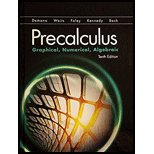
To find the minimum distance between the ball and the person K.
17.6786 feet
Given information:
The person S stands 80 ft to left of the bottom of a Ferris wheel of radius 60 feet. At that instance the person K is at 3’clock on the Ferris wheel. The person S throws a ball with a velocity of 100 ft/sec and an angle of with horizontal of 70∘ .
Calculation:
The angle 70∘ in radian equals 70180π=7π18 .
Assume that the lowest point of the Ferris wheel is at the ground.
The parametric equation for the path of the ball is x(t)=−80+100cos(718π)t , y(t)=−16t2+100sin(718π)t .
And, the parametric equation of the Ferris wheel is x(t)=60cos(π6t) , y(t)=60+60sin(π6t) .
Now, the minimum distance between the ball and the person K will be at a time when the ball is just above the head of the person. At that time −80+100cos(718π)t=60cos(π6t) .
The solution of −80+100cos(718π)t=60cos(π6t) is t≈2.6545 .
Now, the minimum distance between the ball and the person is the difference in height of the ball and the person at time t≈2.6545 sec.
Therefore, the minimum distance is (−16(2.6545)2+100sin(718π)(2.6545))−(60+60sin(π6×2.6545))≈17.6786 feet .
Conclusion:
The minimum distance between the ball and the person K is 17.6786 feet .
Chapter 6 Solutions
EBK PRECALCULUS:GRAPHICAL,...-NASTA ED.
- Pls help ASAParrow_forward9. a) Determie values of a and b so that the function is continuous. ax - 2b f(x) 2 x≤-2 -2x+a, x ≥2 \-ax² - bx + 1, −2 < x < 2) 9b) Consider f(x): = 2x²+x-3 x-b and determine all the values of b such that f(x) does not have a vertical asymptote. Show work.arrow_forwardPls help ASAParrow_forward
- 3. True False. If false create functions that prove it is false. Note: f(x) = g(x). a) If_lim ƒ(x) = ∞ and_lim g(x) = ∞,then_lim [ƒ(x) − g(x)] = 0 x→ 0+ x→0+ x→0+ b) If h(x) and g(x) are continuous at x = c, and if h(c) > 0 and g(c) = 0, then h(x) lim. will = x→c g(x) c) If lim f(x) = 0 and lim g(x) = 0 then lim f(x) does not exist. x-a x-a x→a g(x)arrow_forwardPls help ASAParrow_forward15. a) Consider f(x) = x-1 3x+2 and use the difference quotient to determine the simplified expression in terms of x, for the slope of any tangent to y = f(x). Also, determine the slope at x = 2. 15 b) Determine the equation of the tangent to f(x) at x = 2. Final answer in Standard Form Ax + By + C = 0, A ≥ 0, with no fractions or decimals.arrow_forward
 Calculus: Early TranscendentalsCalculusISBN:9781285741550Author:James StewartPublisher:Cengage Learning
Calculus: Early TranscendentalsCalculusISBN:9781285741550Author:James StewartPublisher:Cengage Learning Thomas' Calculus (14th Edition)CalculusISBN:9780134438986Author:Joel R. Hass, Christopher E. Heil, Maurice D. WeirPublisher:PEARSON
Thomas' Calculus (14th Edition)CalculusISBN:9780134438986Author:Joel R. Hass, Christopher E. Heil, Maurice D. WeirPublisher:PEARSON Calculus: Early Transcendentals (3rd Edition)CalculusISBN:9780134763644Author:William L. Briggs, Lyle Cochran, Bernard Gillett, Eric SchulzPublisher:PEARSON
Calculus: Early Transcendentals (3rd Edition)CalculusISBN:9780134763644Author:William L. Briggs, Lyle Cochran, Bernard Gillett, Eric SchulzPublisher:PEARSON Calculus: Early TranscendentalsCalculusISBN:9781319050740Author:Jon Rogawski, Colin Adams, Robert FranzosaPublisher:W. H. Freeman
Calculus: Early TranscendentalsCalculusISBN:9781319050740Author:Jon Rogawski, Colin Adams, Robert FranzosaPublisher:W. H. Freeman
 Calculus: Early Transcendental FunctionsCalculusISBN:9781337552516Author:Ron Larson, Bruce H. EdwardsPublisher:Cengage Learning
Calculus: Early Transcendental FunctionsCalculusISBN:9781337552516Author:Ron Larson, Bruce H. EdwardsPublisher:Cengage Learning





